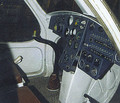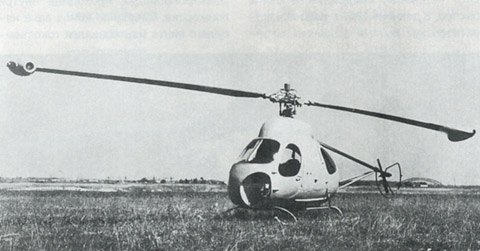|
|
Experimental 4-seat light helicopter with egg-shaped fuselage, skid u/c, thin triangulated tail boom structure, powered by two AI-7 tip-mounted ramjets. One Prot. FF 1959. R.Simpson "Airlife's Helicopter and Rotorcraft", 1998
Few details available of this experimental tip-drive helicopter completed 1959. Pilot and three passengers in stressed-skin nacelle with three doors, tail on tubular boom, skid landing gear and kerosene tank in roof. All-metal blades (related to final Mi-1 but shorter) carrying subsonic tip ramjets. Hub of design unlike other Mil helicopters. Inclined drive shaft to tail rotor. Believed never flew with more than pilot on board, and never publicized. Bill Gunston "The Osprey's Encyclopedia of Russian Aircraft", 2000
 |
Mil V-7
|
 |
Mil V-7 helicopter model
|
 |
V-7 test batch assembly
|
 |
V-7 engine starting
|
 |
V-7 engine starting
|
 |
V-7 experimental helicopter in the Soviet Air Force museum in Monino
|
 |
V-7 experimental helicopter in the Soviet Air Force museum in Monino
|
 |
V-7 tail rotor
|
 |
V-7 experimental helicopter in the Soviet Air Force museum in Monino
|
| Technical data for Mil V-7
Engine: 2 x AI-7,
rotor diameter: 11.6m,
loaded weight: 835kg,
empty weight: 730kg
|
Warning: mysqli_connect(): php_network_getaddresses: getaddrinfo for mysql5.zone.ee failed: Name or service not known in /data03/virt15346/domeenid/www.aviastar.org/htdocs/helicopters_eng/mi-7.php on line 146
Fatal error: Uncaught mysqli_sql_exception: php_network_getaddresses: getaddrinfo for mysql5.zone.ee failed: Name or service not known in /data03/virt15346/domeenid/www.aviastar.org/htdocs/helicopters_eng/mi-7.php:146
Stack trace:
#0 /data03/virt15346/domeenid/www.aviastar.org/htdocs/helicopters_eng/mi-7.php(146): mysqli_connect('mysql5.zone.ee', 'd14657sa18989', Object(SensitiveParameterValue))
#1 {main}
thrown in /data03/virt15346/domeenid/www.aviastar.org/htdocs/helicopters_eng/mi-7.php on line 146
|





